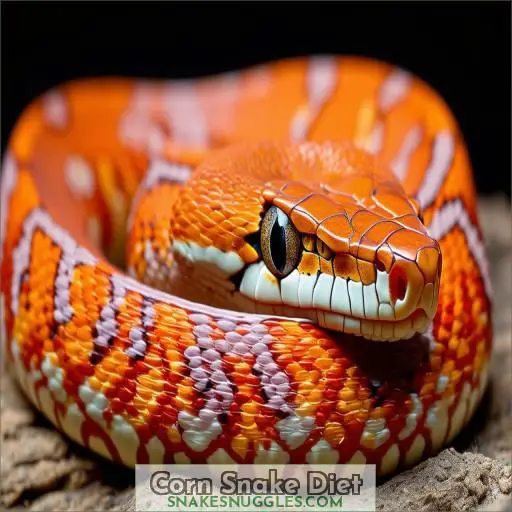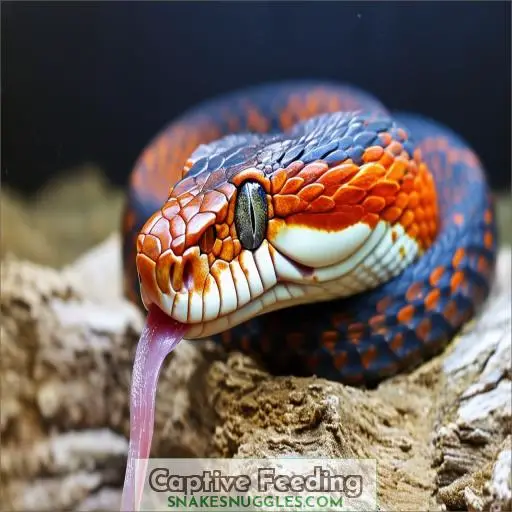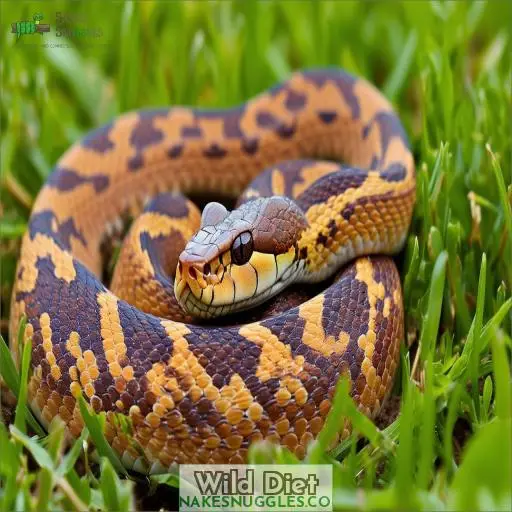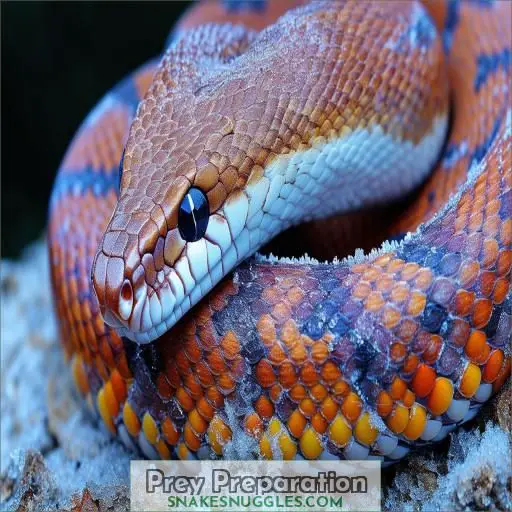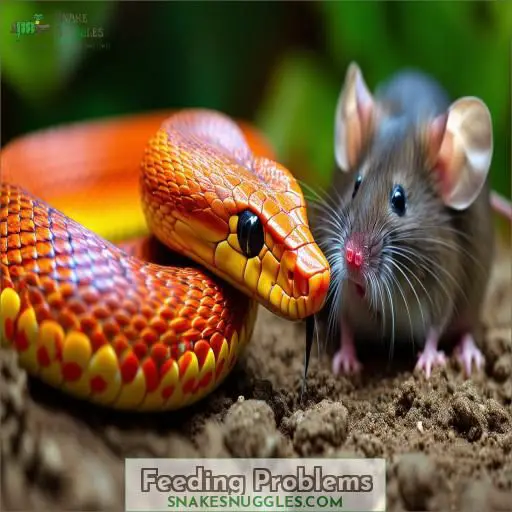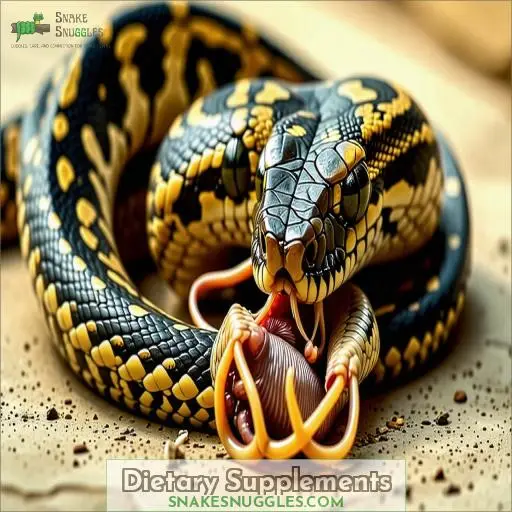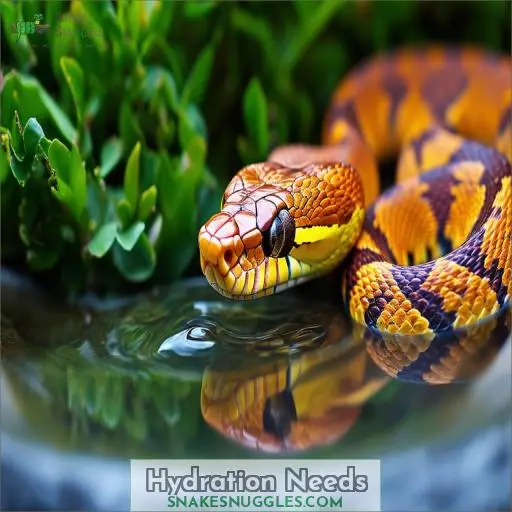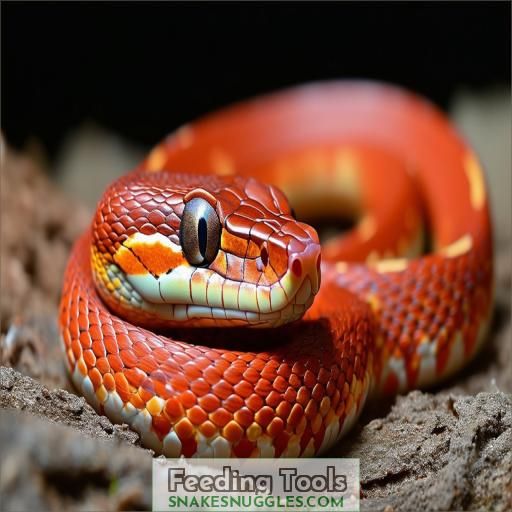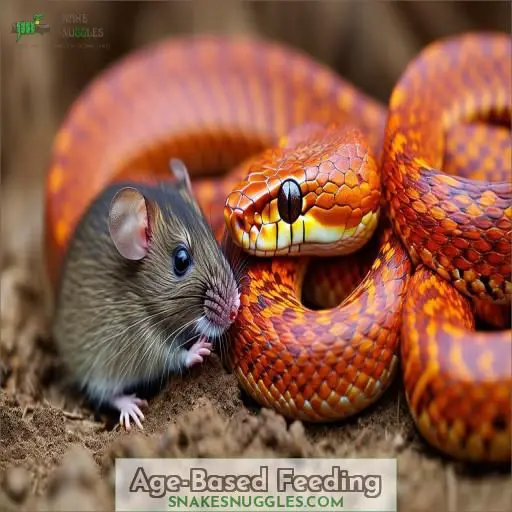This site is supported by our readers. We may earn a commission, at no cost to you, if you purchase through links.
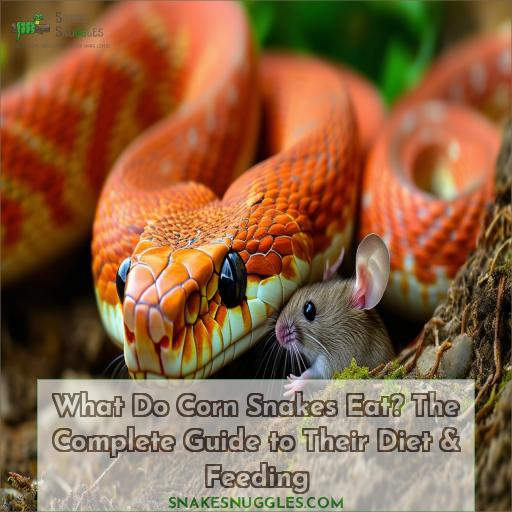
In captivity, you’ll want to provide them with appropriately sized, pre-killed prey items like frozen-thawed mice, rats, or quails on a consistent feeding schedule. Varied diet and proper prey preparation techniques are vital.
If you’re attentive to their feeding response and body condition, you’ll guarantee a healthy corn snake. But there’s more to explore regarding age-specific needs, supplements, and tackling potential feeding issues.
Table Of Contents
- Key Takeaways
- What Do Corn Snakes Eat in the Wild and in Captivity?
- Corn Snake Diet
- Captive Feeding
- Wild Diet
- Prey Preparation
- Feeding Problems
- Dietary Supplements
- Hydration Needs
- Feeding Tools
- Age-Based Feeding
- Feeding Schedules
- Frequently Asked Questions (FAQs)
- What do corn snakes eat in captivity?
- What can I feed my corn snake if I don’t have mice?
- Do corn snakes do well in captivity?
- What do corn snakes need in their habitat?
- What are the risks of overfeeding?
- How to transition to new prey types?
- Signs of prey item refusal or stress?
- Can corn snakes eat pre-killed prey?
- Conclusion
Key Takeaways
- In the great outdoors, these slithery serpents are true gourmands, savoring every morsel from juicy rodents to feathered friends and even the occasional amphibian amuse-bouche. Talk about a diverse palate!
- As pampered pets, however, these corn-fed cuties happily dine on simpler fare of frozen-thawed mice, rats, or quail – a veritable smorgasbord of protein-packed delicacies. Who needs a Michelin star when you’ve got a well-stocked freezer?
- But don’t be fooled by their simple tastes – these snakes are discerning diners. The prey must be properly sized (around 1.5 times their girth) and served at the perfect temperature. No lukewarm leftovers for these refined reptiles!
- And just like any foodie worth their salt, variety is the spice of life for a corn snake. Keep them interested by mixing up their menu with different proteins and tossing in some calcium and vitamin supplements for good measure. A balanced diet is key to a happy, healthy noodle.
What Do Corn Snakes Eat in the Wild and in Captivity?
In the wild, corn snakes primarily eat small rodents, birds, frogs, and other small animals. In captivity, corn snakes are typically fed frozen and thawed mice or rats that are appropriately sized for the snake.
Corn Snake Diet
As a corn snake owner, you want to guarantee your pet enjoys a balanced, nutritious diet.
These carnivorous beauties naturally feast on small mammals, birds, and reptiles in the wild. In captivity, however, their dietary needs are met with pre-killed prey items like mice, rats, or quails.
A varied diet promotes ideal health, so switch up their meals occasionally. Monitor your corn snake’s feeding response and body condition to determine the ideal prey size – around 1.5 times their body’s widest point.
With proper food preparation and a consistent feeding schedule, your scaly companion will thrive on a well-rounded menu designed to meet their needs.
Captive Feeding
When maintaining corn snakes as pets, it’s paramount to provide the appropriate prey types and maintain a consistent feeding schedule. You’ll want to offer properly sized frozen-thawed mice, rats, or other approved feeder animals, following age-specific feeding guidelines to guarantee your snake’s nutritional needs are fulfilled.
Appropriate Prey Types
In selecting suitable prey, provide your corn snake with a varied diet. Mice, both frozen and live, are primary options, but consider offering small rats, quail, or even geckos for variety. Frozen prey is convenient and easily accessible, but verify that it’s properly thawed and of an appropriate size. Variety maintains your snake’s interest and provides essential nutrients.
Feeding Schedule
You’ll need to establish a consistent feeding schedule. Here’s what to follow:
- Hatchlings: Feed pinkies every 5-7 days
- Juveniles: Offer fuzzies every 7-10 days
- Adults: Provide appropriately sized prey every 10-14 days
- Adjust frequency to maintain ideal body condition
Feeding at night in a separate enclosure minimizes stress. Use tongs and avoid handling for 24-48 hours after meals to prevent regurgitation.
Prey Size Guidelines
Along with a consistent feeding schedule, you’ll need to offer appropriately-sized prey. As a general rule, the prey width shouldn’t exceed 1.5 times your corn snake’s body width at its widest point. Here’s a handy reference table:
| Snake Age | Prey Size |
|---|---|
| Hatchling | Pinky mice |
| Juvenile | Fuzzy mice |
| Adult | Adult mice |
This ensures your pet can consume and digest the prey without issues. Larger prey risks regurgitation or impaction.
Wild Diet
In the wild, corn snakes primarily prey on small rodents like mice, rats, and voles, as well as birds, lizards, frogs, and other small vertebrates. Their hunting techniques involve ambushing prey, using their heat-sensing pits to detect warm-blooded animals, and constricting their prey before swallowing it whole.
Natural Prey Species
Out in their natural habitats, corn snakes are opportunistic predators that consume a variety of small mammals, birds, and amphibians.
While juvenile corn snakes primarily feed on lizards and frogs, adults target larger prey like rats, adult mice, and even bird eggs.
Their dietary adaptations allow habitat overlap and niche partitioning with other snake species through competitive feeding and prey sharing.
Hunting Behaviors
As hunters, corn snakes employ stealth and ambush tactics. They lie motionless, sensing prey via heat sensors and hunting mostly at night when rodents are active. Favoring wooded areas and rocky outcrops, they stalk nests and burrows, constricting warm-blooded prey or swallowing cold-blooded prey whole. Varied techniques and adaptable hunting behaviors maximize success across diverse habitats.
Seasonal Variations
In the wild, corn snakes’ appetites fluctuate seasonally. As temperatures rise in spring, their metabolism increases, driving them to hunt more frequently. During summer’s peak heat, however, they may become sluggish picky eaters. Come fall’s cooling, their feeding resumes in preparation for winter’s scarce prey. Adapting to these rhythms prevents issues like regurgitation and promotes shedding.
Prey Preparation
For proper prey preparation, you’ll need to thaw frozen prey thoroughly before offering it to your corn snake. Use approved warming techniques like soaking the prey item in warm water or placing it in a food-safe container in warm water until it reaches an appropriate temperature, taking care to avoid overheating which can promote bacteria growth.
Thawing Frozen Prey
Done properly, thawing frozen prey is essential:
- Never microwave; it’s hazardous
- Refrigerator overnight is best
- Add prey to warm water bath, monitor temp
- Use a hopper or dish to contain small feeders
Following safe techniques maintains food quality while minimizing bacteria growth, ensuring your corn snake receives a nutritious meal. Trust local experts like Northampton Reptile Centre for guidance on proper thawing.
Warming Techniques
After thawing, you’ll need to warm the prey to body temperature. Using warm water is safest, but never microwave – it can cause dangerous hot spots. Here’s a handy guide:
| Method | Temp Range | Pros | Cons |
|---|---|---|---|
| Water Bath | 95-100°F | Even heating, less risk | Time consuming |
| Warm Towel | 90-100°F | Quick, portable | Uneven warming |
| Air Circulation | 85-95°F | Hands-free, mimics nature | Slow, potential dehydration |
Improper warming can sicken your corn snake, so take care during this essential step.
Handling Precautions
After thawing and warming the prey properly, be mindful of handling precautions:
- Only handle prey with tongs or forceps
- Avoid direct contact with prey after handling snake
- Wash hands thoroughly before and after handling prey
Careful handling techniques guarantee safe feeding while minimizing risks of bites or contamination. Consistency is key for stress-free feeding sessions.
Feeding Problems
Overfeeding can lead to obesity, regurgitation, and other health issues for your corn snake. It’s essential to monitor their body condition and adjust prey size and feeding frequency accordingly.
Underfeeding, on the other hand, can cause weight loss, lethargy, and compromised immune function. A picky eater may require adjustments to prey type, temperature, or feeding techniques to encourage proper intake.
Overfeeding Risks
Overfeeding corn snakes poses risks of obesity and associated health issues, which can exacerbate corn snake health issues and symptoms. Overfeeding corn snakes poses risks of obesity and associated health issues.
Restrict feeding frequency and prey size to suitable levels for the snake’s age and physical condition.
A diverse diet with appropriately sized prey items is essential for maintaining healthy captive care.
Observe weight, activity levels, and droppings for indicators of overfeeding.
Adjusting portions ensures dietary variety and feeding frequency don’t compromise the snake’s well-being.
Underfeeding Signs
While overfeeding poses risks, underfeeding can also harm your corn snake. Signs of underfeeding include:
- Poor body condition (visible spine and hips)
- Lethargy and lack of energy
- Skin issues like dull scales or retained sheds
If you notice weight loss or your snake refuses food, adjust its feeding schedule. A well-fed corn snake has a plump body and is active during handling.
Picky Eaters
Picky eating in corn snakes can be frustrating, but you’ve got options. Try varying prey types or sizes as their tastes evolve. Scenting prey, adjusting temperatures, using feeding tools, or imitating movement can entice stubborn snakes. Underlying issues like improper husbandry, stress, or health concerns may also cause pickiness—addressing root causes is key.
Dietary Supplements
To guarantee your corn snake receives the proper nutrients, you’ll want to provide calcium and multivitamin supplements. Calcium is critical for strong bones and proper muscle function, while multivitamins provide a range of essential vitamins and minerals. Additionally, gut loading prey with nutrient-rich foods before feeding can help increase the nutritional value passed on to your snake.
Calcium Needs
You’ll need to provide supplemental calcium for your corn snake’s skeletal health. Calcium deficiency can lead to metabolic bone disease. Dust prey with a calcium supplement 2-3 times weekly. Good calcium sources include cuttlebone, oyster shell, or commercial reptile calcium powders. Proper calcium levels promote efficient calcium absorption.
Multivitamins
In addition to calcium, you’ll need to supplement your corn snake’s diet with multivitamins for a complete nutritional package
. Hatchlings and juveniles require more vitamins for proper growth, so dust prey with a reptile multivitamin every other feeding. For adults, supplement monthly. Watch for vitamin deficiency symptoms like lethargy, poor appetite, and abnormal shedding.
Gut Loading
In addition to dusting prey with supplements, consider "gut loading" – the practice of feeding nutrient-rich foods to feeder insects before feeding them to your corn snake. This helps guarantee those essential nutrients get passed along. Diversify gut loading foods like carrots, potatoes, and commercial gut loads for ideal nutrient variety.
Hydration Needs
Proper hydration is essential for corn snakes’ well-being. Here are three key hydration requirements:
- Fresh Water: Provide a clean water bowl large enough for your snake to soak in, and change the water frequently. Snake dehydration can lead to poor body condition and health issues.
- Humidity Levels: Maintain enclosure humidity between 40-60% using a hygrometer to monitor levels. Proper humidity aids shedding and prevents respiratory infections.
- Electrolyte Balance: If your snake appears dehydrated, use pedialyte mixed with water as a rehydration solution, but consult a reptile vet before administering fluid therapy.
Monitor your corn snake’s body condition, activity levels, and skin quality for signs of dehydration like sunken eyes, lethargy, or stuck sheds. Keeping their hydration needs in mind ensures overall health.
Feeding Tools
To feed your corn snake, you’ll need feeding tools like tongs or forceps to safely handle the prey and prevent getting bitten. A shallow feeding dish helps contain any mess and makes cleaning easier after meals. Proper sanitation by washing dishes thoroughly with soap and hot water after each feeding session is essential to prevent bacterial growth.
Tongs and Forceps
You’ll need appropriate feeding equipment like long-handled tongs or forceps to present prey safely. Corn snakes are non-venomous constrictors, but they may defensively strike at caregivers while feeding. Proper handling techniques minimize stress and potential bites. With some practice, you can confidently offer prey using tongs while avoiding accidental nips.
Feeding Dishes
You’ll need a designated feeding dish. Consider these options:
- Shallow ceramic or plastic dishes with smooth surfaces
- Disposable paper plates or cups for easy cleaning
- Non-porous materials that won’t absorb smells or bacteria
- Separate dishes for water and food to avoid contamination
Offering variety in both prey and feeding tools enriches your corn snake’s environment.
Sanitation
You can’t overlook hygiene when feeding corn snakes. Properly sterilize feeding tongs and dishes, and handle prey with utmost care. Frozen prey should be stored hygienically, thawed safely, and any uneaten portions discarded to prevent bacterial growth that could jeopardize your snake’s nutrition and health.
Age-Based Feeding
A corn snake’s dietary needs evolve as it matures.
You should adjust the prey size, type, and feeding frequency to accommodate their changing metabolism and growth rate.
Hatchlings require smaller prey items (like pinky mice) every 5-7 days.
Juveniles can consume larger mice weekly.
Adults can go up to 2-3 weeks between feedings with appropriately sized rats or jumbo mice.
Hatchling Requirements
For hatchlings, keep humidity around 60%, use a small enclosure, and handle minimally. Acclimate hatchlings slowly, offering appropriately-sized prey every 5-7 days. Enrichment like hides and branches encourages natural behaviors. Monitor their weight closely, adjusting prey size as needed. Proper temperatures, humidity, and enclosure furnishings guarantee their best start in life.
Juvenile Feeding
For juveniles, feed every 7-10 days. Offer varied prey like mice, fuzzy rats, and small quail—not exceeding 1.5 times the snake’s width. Gently handle first, avoiding grips near the head. Dust prey with calcium/multivitamin supplements biweekly to support growth. With patience, juveniles quickly acclimate to captive feeding routines.
Adult Feeding
For adult corn snakes, you’ll feed every 10-14 days, adjusting based on their body condition. Offer appropriately sized prey, around 1.5 times their body width, to prevent obesity. While mice are standard, consider varying with rats, quail, or small birds for enrichment and nutrition. Captive-bred prey is safest. Avoid handling for 24-48 hours after feeding.
Feeding Schedules
When corn snakes enter brumation (a seasonal slowing of metabolism), their feeding schedules should be adjusted accordingly. You’ll need to reduce meal frequency and size during this period, as their energy requirements are lower. Additionally, pre-shed corn snakes may be more reluctant to eat, so you may need to temporarily pause feeding until the shed is complete.
Brumation Adjustments
During brumation, you’ll need to adjust your corn snake’s feeding schedule. As they enter this hibernation-like state, their metabolism slows, so:
- Reduce meals gradually
- Fast completely for 2-3 months
- Monitor weight closely
Brumation typically lasts 3-4 months. Maintain proper temperatures, around 60-65°F, and allow the snake to shed before and after this fasting period.
Seasonal Changes
You’ll also need to adjust your corn snake’s feeding schedule based on seasonal changes. Their appetites naturally fluctuate with temperature and daylight variations, like during the warmer months when they’re more active and have higher metabolic rates. Pay close attention to their hibernation patterns and breeding season, as these factors influence their hunger levels too.
Pre-Shed Considerations
You’ll notice your corn snake’s appetite decreases leading up to shedding. Don’t be alarmed—this loss of interest in food coincides with their shedding cycle. Just provide a humid hiding spot and avoid handling to prevent skin sensitivity. Offer water, but don’t be surprised if they refuse meals until after completing their shed.
Frequently Asked Questions (FAQs)
What do corn snakes eat in captivity?
In captivity, corn snakes thrive on a carnivorous diet. Feed appropriately sized mice, rats, or quail – prey should be no wider than 5 times the snake’s body. Vary proteins and supplement with calcium and vitamins.
What can I feed my corn snake if I don’t have mice?
You can feed your corn snake other prey items like quails, rats, lizards, or small birds. Vary its diet by offering different prey types that are appropriately sized and safely sourced.
Do corn snakes do well in captivity?
Yes, corn snakes thrive in captivity if their basic needs are met – proper housing, thermal gradient, humidity levels, and a varied diet. With attentive care, these docile snakes make excellent captive pets.
What do corn snakes need in their habitat?
You’ll need an enclosure with proper temperatures, humidity levels, hiding spots, and substrate. Provide climbing branches, clean water, and UV lighting to mimic their natural habitat.
What are the risks of overfeeding?
Overindulging your scaly friend can lead to a weighty problem – obesity puts undue strain on their organs. Don’t let greed blind you; stick to proper portion sizes for a lithe, lively corn snake.
How to transition to new prey types?
Gradually introduce new prey by offering alongside familiar items. Start with small portions, increasing over weeks. Monitor hunger cues closely during change periods to prevent regurgitation or rejection of unfamiliar prey.
Signs of prey item refusal or stress?
You’d think refusing a meal was no big deal, but for snakes, it’s a red flag – stress, illness, or something amiss. Stay alert for repeated refusals, lethargy, or abnormal behavior – time to troubleshoot your scaly companion’s care.
Can corn snakes eat pre-killed prey?
Yes, corn snakes can eat pre-killed, frozen-thawed prey. This is preferable for home care as live feeding risks injury. Properly thawed rodents provide essential nutrients and are safe for these constrictors.
Conclusion
Satire aside, properly understanding what corn snakes eat in the wild and captivity is vital for their well-being.
By mimicking their natural diet, providing appropriate prey types and sizes, employing safe feeding practices, addressing issues promptly, and adjusting for age and seasons, you’ll guarantee these fascinating reptiles thrive under your care.
Mastering their dietary needs is an integral part of responsible corn snake ownership.

